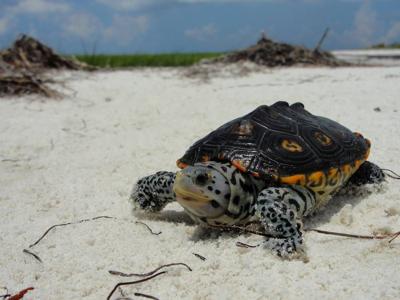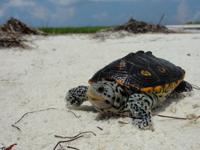The Maryland Coastal Bays Program is seeking volunteers to participate in the Annual Diamondback Terrapin count beginning May 31 through June 11.
The surveys take place in the Coastal Bays including brackish-water creeks throughout the designated week. Counts take place both on water and on land. From motorboats, kayaks, and SUPs, all are encouraged to participate.
The diamondback terrapin is more than just a school mascot or the Maryland state reptile — it is the symbol for healthy and productive coastal bays. This turtle is comfortable on both land and in the water, calling the area's marshes, beaches, and bays home. Officials said that while we can see terrapins almost anywhere on the Eastern Shore, there is still much to learn about this elusive turtle.
Terrapins are perfectly suited for the Coastal Bays ecosystem. Not only do they have long nails that they can use for digging or climbing on land, but they also have webbed feet that allow them to swim and dive for food. Because terrapins spend most of their time in the water hunting for food, they have evolved the ability to hold their breath for a long period of time since they do not possess gills; a mature terrapin can hold its breath anywhere from 45 minutes to five hours.
These surveys have been occurring after Memorial Day for the past eleven years as this is the time period when terrapins are highly active and are aggregating in clusters after emerging from hibernation.
Terrapins are the only turtle occupying brackish water, but other turtles, such as snapping turtles, could venture into more brackish water, so it is important that you are trained to identify the correct species. There is a training link provided on the MCBP website that includes turtle identification, protocol for conducting a survey, data sheets and survey locations.
One of the biggest problems facing terrapin populations in the Coastal Bays are crab pots — especially “ghost pots,” which are crab pots that are no longer attached to a marker or float so they will never get hauled in and collected. Crab pots are dangerous for terrapins, especially the smaller males and immature terrapins, because they are lured into the pots by the crab bait, get stuck and then drown in the traps because they need to surface to breathe.
The best way to solve this problem is to equip all crab pots with Bycatch Reduction Devices. BRDs are orange plastic and wire rectangles that are large enough to let crabs through but small enough to block terrapins from getting into the pots and getting stuck. For them to work they need to be about 1 3/4 inches wide and 4 3/4 inches long. Some crab pots sold today already have BRDs installed; however, if you buy a pot without one, they are cheap to buy or build and easy to install with directions on the Maryland Department of Natural Resources website https://dnr.maryland.gov/wildlife/documents/TerrapinBrochure.pdf


